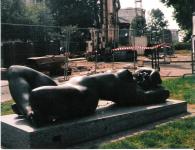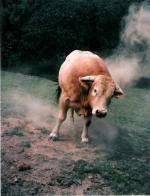|
Pentax Auto 110 |
Manufactured or assembled in Japan from 1979 to 1982.
Index of rarity in France: Rare (among non-specialized garage sales)
Inventory number: 1488
See the complete technical specifications
Chronology of cameras Pentax
Traduction de Luc Moreau
The "small" Pentax reflex had been presented at the 1978 Photokina. It arrived in France in early 1980.
It was designed as the central piece of a complete photographic system and it's commonly found as a complete kit, packed in a transport case, including the body, three lenses, a strobe, a pouch, a winder and close-up lenses. The whole package doesn't exceed 51.5 x 24 cm.
The Auto 110 was a real SLR with interchangeable lenses, only smaller. Pentax had been innovating by presenting, as a blueprint, the first TTL SLR, even though the Topcon RE Super was the first one to reach the shelves (then they finally released the Spotmatic some time later, without its spot metering, keeping only a center-weighted average metering!). This time the Pentax engineers were indeed the first to release a 110 SLR, and included everything a photographer could dream of.
The Auto 110 has a TTL lightmeter. The metering is center-weighted, optimized for landscape framing. The cell is powered by two silver oxide batteries, that need to be mounted in a special holder that can then be inserted into the camera, at the right of the 110 cartridge. Half-depressing the shutter release button powers up the meter circuit. The automatic exposure supports the range of 1 second at f/2.8 through 1/750 second at f/13.5. In the viewfinder, a green LED shows up if the shutter speed is above 1/30 sec, otherwise it's orange.
The shutter release button, though entirely mechanical, is very smooth. It doesn't feature a lock, but the winding is of the two-stroke variety: at the first one, only the film advance is performed. The shutter is cocked only at the second stroke. So it is possible to carry the camera with the film already advanced, without battery consumption or risk of accidental shutter release.
The viewfinder seems very large and bright, taking the small size of this camera into account. At the center of the very fine focusing screen there's a stigmometer focusing aid (horizontal), without microprisms. The next version, the Auto 110 Super, released in 1982, will feature micro-prisms on the screen. The lower right corner has a spot reserved for the LEDs indicating the auto exposure parameters.
The lenses have a specific bayonet mount (surprise, surprise...). To unlock, you'll need to push up a small lever (visible at the right of the lens). The combined shutter/diaphragm is attached to the body to minimize the cost of the lenses and simplifies the bayonet coupling (there's none). The diaphragm is diamond-shaped because it is made of only two blades with a square angle.
Like for all 110-format cameras, loading film is very easy. Open the back, drop the cartridge into its slot, close the back, done ! The problem with 110 cartridges is that even though they can be loaded with 50, 64, 80, 100 or 125 ASA, they are all handled by the camera as the same sensitivity, because the small bit at the far right of the cartridge has the same length and pushes the sensor in the camera in the same way whatsoever, making it believe you've loaded 100 ASA film. Which is not really a big issue with most entry-level Instamatic cameras, but not so in this case, due to the precise metering system. It should be better to use only 100 ASA film. In case no pressure is applied, the camera interprets this as 400 ASA sensitivity.
The custom flash AF 130 P (guide number 13 in meters) screws itself to the camera. The plastic cover at the right side of the prism must be removed to uncover the female screw. At the far right, a small cover is protected in a small recessed area. When the flash is mounted, this button gets pressed to indicate to the camera that it's in good company. The camera automatically switches to the 1/30 sec shutter sync speed.
This Lilliput camera weights 172 grams including the standard lens. This lens is the 24 mm f/2.8. The telephoto lens is the 50 mm f/2.8 and the wide angle is the 18 mm f/2.8. There was also a 70 mm f/2.8 and a 20-40 mm f/2.8 zoom lens. These focal lengths are equivalent to 50, 100, 35, 135 40-80 mm respectively. v Some lenses have been released after the initial kit release date, thereby adding to the set of available options.
|
Optical formula
|
Field of View
|
Min focus dist |
Filter diameter
|
Diameter and length | Weight | |
|
Normal :
Pentax 110 24 mm f/2,8 |
6 eléments 5 groups
|
47°
|
0,35 m
|
25,5 mm
|
29,6 mm x 12,8 mm
|
13 g
|
|
Grand Angulaire :
Pentax 110 18 mm f/2,8 |
6 elements 5 groups
|
61,5°
|
0,25 m
|
30,5 mm
|
34 x 21 mm
|
28 g
|
|
Télé-objectif : Pentax 110 50 mm f/2,8
|
5elements 5 groups
|
24°
|
0,9 m
|
37,5 mm
|
43 x 27,2 mm
|
53 g
|
The winder attaches to the camera by screwing into the tripod attachment. It has a grip shape that makes handling easier. Two 1.5V batteries allow for 1200 frames. Its maximum speed is 2 frames/sec, but it can only advance the film after the shutter release button comes back in the upper position, confirming that its indeed a winder and not a motor drive. It features a power switch. When inserting a new cartridge, the winder advances until the first frame (which would require 7 strokes in manual mode). The winder weights 112 grams without batteries. There was a small number of filters available (on the release date): UV and Skylight for the 24 mm and 18 mm.
Additional close-up lenses were available for screwing onto the lenses:
for the 24 mm :
- S31 lens focusing distances 20-36 cm
- S16 lens focusing 14-20 cm
for the 18mm :
- W21 lens focusing 16-26 cm
for the 50mm :
- T86 lens focusing 48.5-91.9 cm
- T43 lens focusing 34.4-48.9 cm
Also available were some viewfinder corrective lenses (-5 to +3) for glasses-wearing photographers.

Interesting links or bibliography :
| Sur mes-appareils-photos.fr, suggested by Eric Carlhan |
 PhotoGraphic de 1979 |  PhotoGraphic de 1980 |
Add a link or element of bibliography, a picture taken with this camera, a picture of box or an ads about this camera
Your photos taken with the same camera:

| 
| 
|
Cameras from Ebay France (Pentax) (Uploaded each 3 hours)








